Physiotherapy Clinic Financial Model
This 5-Year, 3-Statement Excel Physiotherapy Clinic Financial Model includes revenue streams from subscription and appointment, booking cost structures, and financial statements to forecast the financial health of your clinic.
Financial Model for A Physiotherapy Clinic
These Physiotherapy Clinic Financial Models involve detailed revenue projections, cost structures, capital expenditures, and financing needs. The model provides an understanding of the financial viability, profitability, and cash flow position of your clinic.
What Do You Get? 2 Models In 1 Zip File
Version 1: has revenues via 5 inputs for PAYG service inputs.
Version 2: has 6 subscription-based revenues and 5 PAYG service inputs
Income Statement (Profit & Loss Statement)
This statement shows the clinic’s revenue, expenses, and net income over a given period.
Revenue (Top Line)
- Consultation Fees – Revenue from initial assessments and physiotherapy sessions.
- Subscription Plans – Monthly/annual memberships for ongoing treatment.
- Specialized Services – Sports therapy, post-operative rehab, massage therapy, acupuncture, etc.
- Product Sales – Sales of therapy equipment (e.g., foam rollers, resistance bands, pain relief products).
- Corporate Partnerships – Revenue from corporate wellness programs or tie-ups with sports teams.
- Insurance Payments – Payments from insurance providers for covered services.
- Workshops & Seminars – Income from educational programs, online courses, or community outreach events.
Cost of Goods Sold (COGS)
- Therapist salaries (if commission-based)
- Supplies used in therapy (e.g., exercise bands, massage oils, electrodes for electrotherapy)
Gross Profit
Gross Profit = Revenue – COGS
Operating Expenses
- Salaries & Wages – Staff salaries (therapists, admin, receptionist, etc.)
- Rent & Utilities – Lease, electricity, water, and internet costs.
- Marketing & Advertising – Website, social media ads, referral programs, etc.
- Insurance – Professional liability, property insurance, and workers’ compensation.
- Equipment Maintenance – Upkeep of treatment beds, ultrasound machines, and other medical tools.
- Software & Subscriptions – EMR software, booking systems, accounting tools.
- Depreciation & Amortization – Equipment and asset depreciation over time.
Operating Profit (EBITDA)
EBITDA = Gross Profit – Operating Expenses
Interest & Taxes
- Interest on business loans (if any).
- Corporate taxes.
Net Profit (Bottom Line)
Net Profit = EBITDA – Interest – Taxes
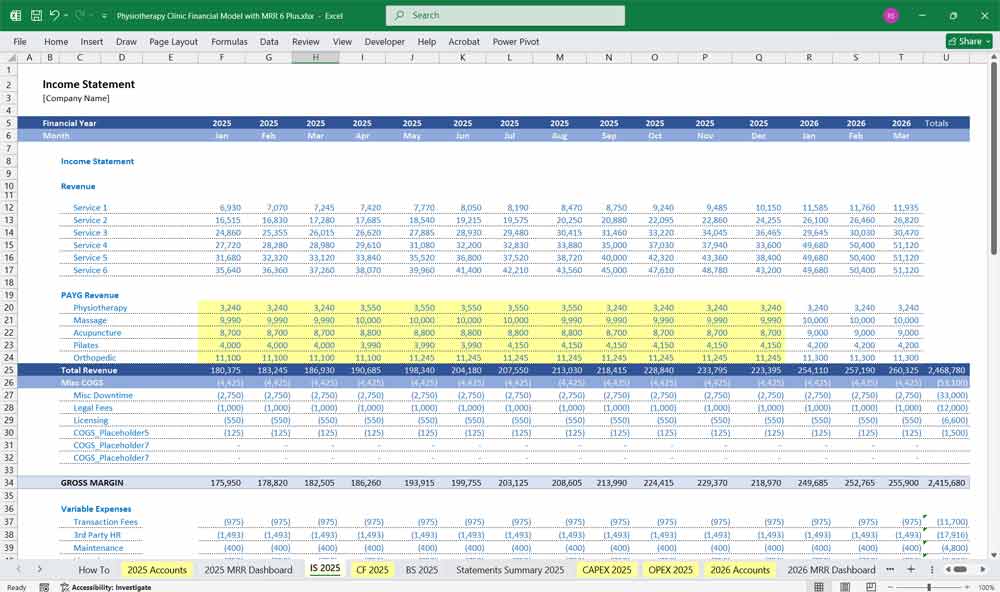
Physiotherapy Clinic Financial Model Cash Flow Statement
This statement tracks how cash moves in and out of the clinic, ensuring liquidity.
Cash Inflows
- Revenue from patient consultations, therapy sessions, and packages.
- Membership and subscription fees.
- Insurance reimbursements.
- Corporate partnerships.
- Loans or investment capital (if applicable).
Cash Outflows
- Rent, salaries, and other overhead expenses.
- Medical supplies and equipment purchases.
- Loan repayments (if any).
- Marketing and business development expenses.
- Taxes and insurance payments.
Net Cash Flow
Net Cash Flow = Total Cash Inflows – Total Cash Outflows
Types of Cash Flow
- Operating Cash Flow – Cash from daily business activities.
- Investing Cash Flow – Cash spent on acquiring new equipment or expanding facilities.
- Financing Cash Flow – Loan repayments, new financing, or owner withdrawals.
A healthy clinic should have a positive operating cash flow, ensuring enough liquidity to cover expenses.
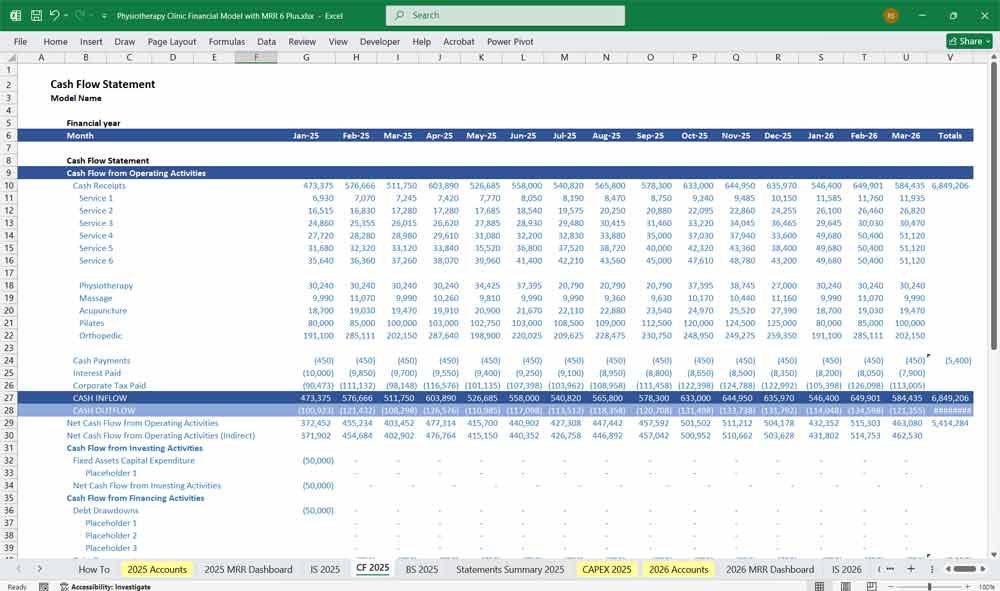
Physiotherapy Clinic Financial Model Balance Sheet
This statement provides a snapshot of the clinic’s financial position at a specific point in time.
Assets (What the clinic owns)
Current Assets
- Cash in hand & bank
- Accounts receivable (insurance claims, unpaid invoices)
- Inventory (therapy products, consumables)
Fixed Assets
- Medical equipment (treatment tables, exercise machines, ultrasound therapy units)
- Furniture & fixtures
- Office computers and software
Liabilities (What the clinic owes)
Current Liabilities
- Accounts payable (supplier bills, unpaid salaries)
- Short-term loans
- Taxes payable
Long-Term Liabilities
- Business loans
- Lease obligations
Equity (Ownership of the business)
- Owner’s Equity – Initial investment from owners.
- Retained Earnings – Profits reinvested into the business.
Balance Sheet Equation:
Assets = Liabilities + Equity
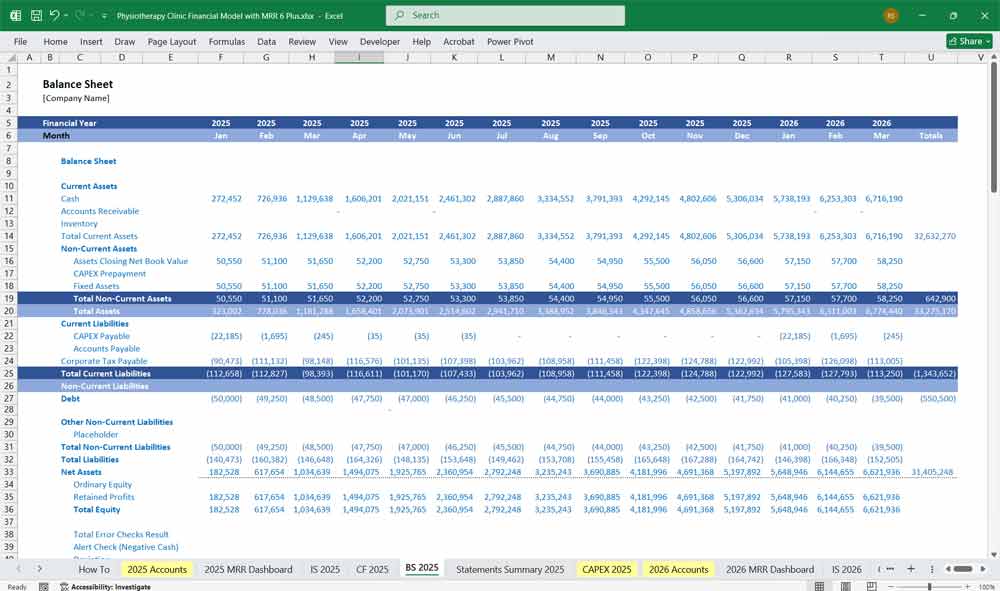
Physiotherapy Clinic – Service Offerings
- Physiotherapy Orthopedic rehabilitation (post-surgery, fractures)
- Physiotherapy sports injury management and prevention
- Physiotherapy Neurological rehabilitation (stroke, MS, Parkinson’s)
- Pediatric physiotherapy (developmental delays)
- Geriatric care (arthritis, balance training)
Physiotherapy Clinic – Patient Assessment and Treatment Plans
- Physiotherapy initial consultation and medical history review
- Physical assessment (range of motion, strength)
- Goal-setting with the patient
- Personalized treatment plan creation
- Progress tracking and plan adjustments
Physiotherapy Clinic – Specialized Therapies
- Physiotherapy Manual therapy (joint mobilization, soft tissue release)
- Physiotherapy Electrotherapy (TENS, ultrasound)
- Physiotherapy Hydrotherapy (aquatic therapy)
- Dry needling and acupuncture
- Vestibular rehabilitation (dizziness, balance)
Physiotherapy Clinic – Equipment and Facility Setup
- Physiotherapy treatment beds and private rooms
- Physiotherapy exercise and rehabilitation equipment
- Physiotherapy hydrotherapy pools or whirlpools
- Physiotherapy waiting area and reception setup
- Physiotherapy cleanliness and hygiene protocols
Physiotherapy Clinic – Staff and Training
- Hiring qualified physiotherapists
- Continuous professional development
- Physiotherapy support staff recruitment (reception, admin)
- Physiotherapy cross-training for multidisciplinary care
- Performance evaluation and feedback
Physiotherapy Clinic – Patient Engagement and Education
- Physiotherapy home exercise program design
- Physiotherapy patient education workshops
- Physiotherapy progress review meetings
- Digital resources (videos, guides)
- Physiotherapy support groups or community engagement
Physiotherapy Clinic – Marketing and Outreach
- Building a referral network (doctors, sports teams)
- Physiotherapy clinic social media content and testimonials
- Community events and free screenings
- Website with booking functionality
- Online advertising and SEO strategies
Physiotherapy Clinic – Financial Management
- Physiotherapy treatment pricing strategy
- Physiotherapy insurance billing and processing
- Physiotherapy cash flow management
- Physiotherapy expense tracking (salaries, supplies)
- Profitability analysis and forecasting
Physiotherapy Clinic – Patient Experience Enhancement
- Physiotherapy Clinic online appointment scheduling
- Personalized follow-up communication
- Comfortable clinic environment
- Feedback collection and improvement
- Celebrating patient milestones
Physiotherapy Clinic – Compliance and Risk Management
- Physiotherapy Licensing and certification adherence
- Physiotherapy Patient data privacy (HIPAA or equivalent)
- Emergency response protocols
- Physiotherapy Insurance and liability coverage
- Continuous policy and procedure review
6-tier subscription model for your physiotherapy clinic
It caters to different needs and budgets:
1. Basic Physiotherapy Recovery Plan ($XX/month)
- 1 physiotherapy session per month
- Access to online exercise guides
- 10% discount on additional sessions
- Email support for basic queries
2. Wellness Maintenance Physiotherapy
Plan ($XX/month)
- 2 physiotherapy sessions per month
- Personalized home exercise plan
- 15% discount on additional sessions
- Priority appointment scheduling
3. Active Lifestyle Physiotherapy Plan ($XX/month)
- 4 physiotherapy sessions per month
- Custom strength & mobility program
- Access to monthly group wellness workshops
- 20% discount on additional sessions
- Virtual check-ins with a therapist
4. Athlete Performance Physiotherapy
Plan ($XX/month)
- 6 physiotherapy sessions per month
- Sports-specific injury prevention & recovery program
- 1 personalized nutrition consultation
- Free access to clinic’s recovery tools (e.g., foam rollers, ice baths)
- 25% discount on additional services
5. Premium Rehab Physiotherapy Plan ($XX/month)
- 8 physiotherapy sessions per month
- In-depth movement analysis
- Custom rehabilitation roadmap
- Complimentary therapeutic massage (1 per month)
- 30% discount on additional services
6. Elite VIP Physiotherapy Plan ($XX/month)
- Unlimited physiotherapy sessions
- Personalized treatment plan with full-body assessment
- Priority booking & concierge scheduling
- Free monthly massage & recovery session
- 40% discount on premium treatments & products
- Access to exclusive members-only workshops
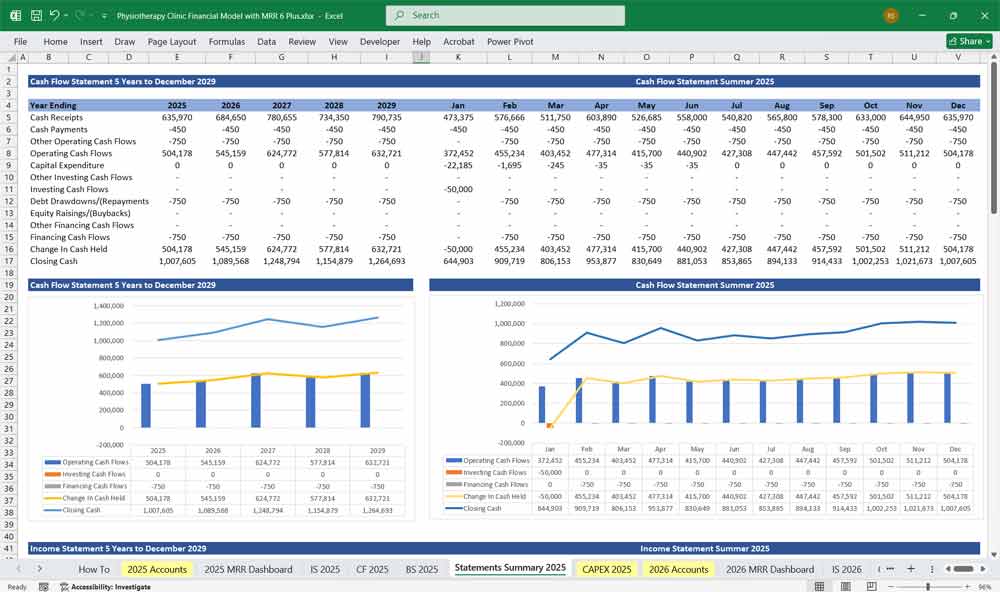
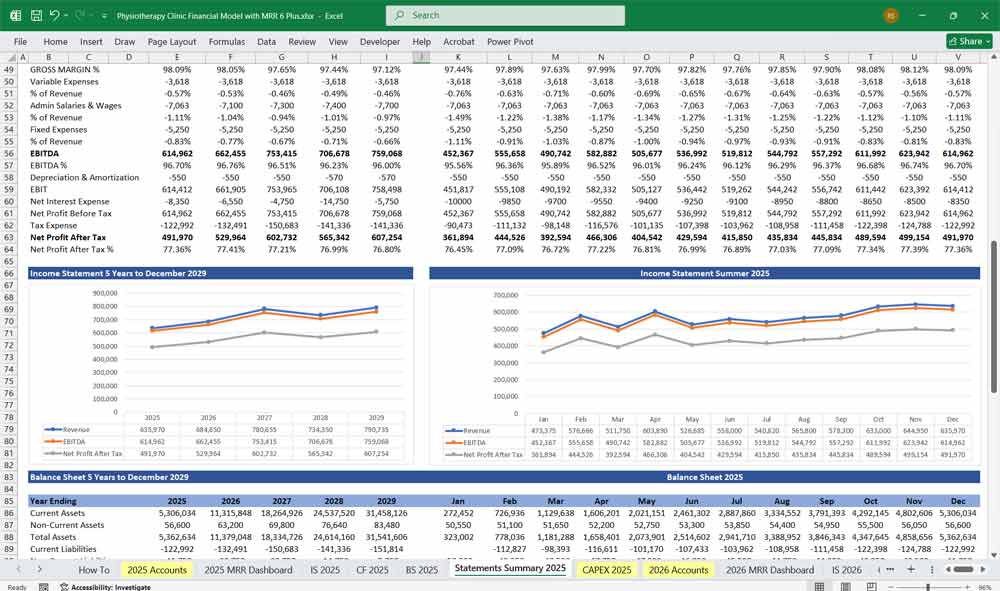
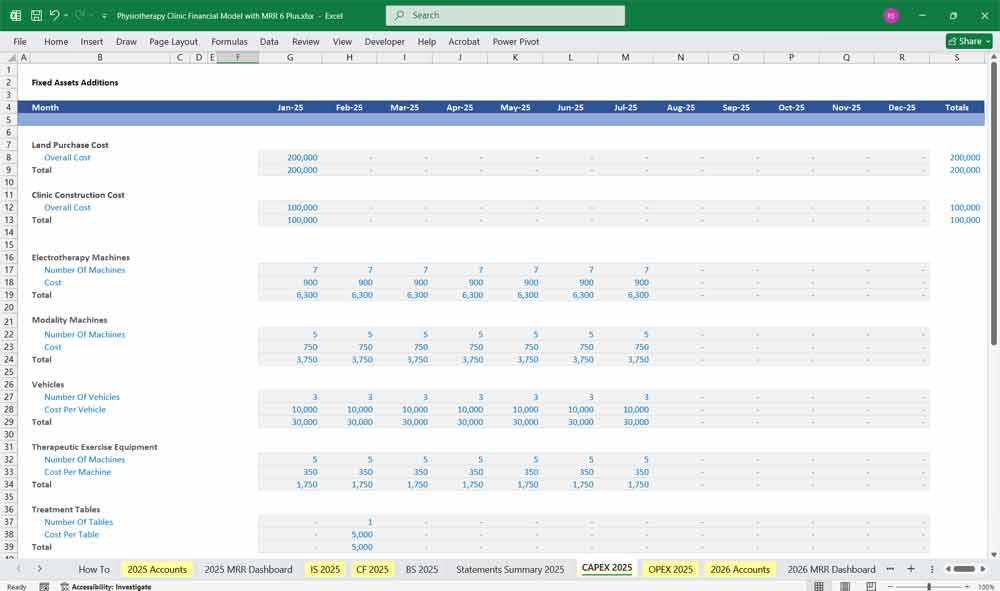
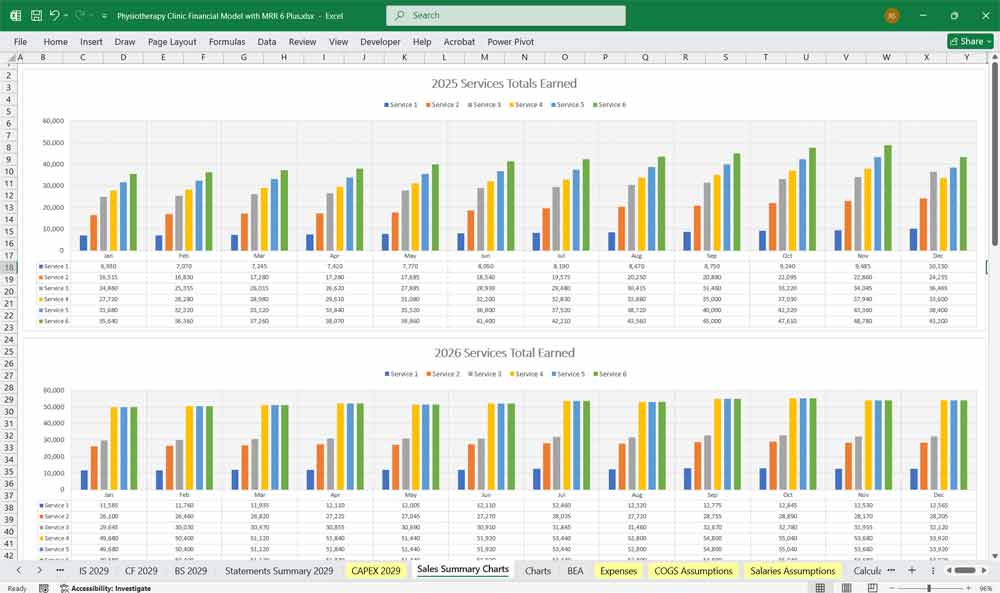
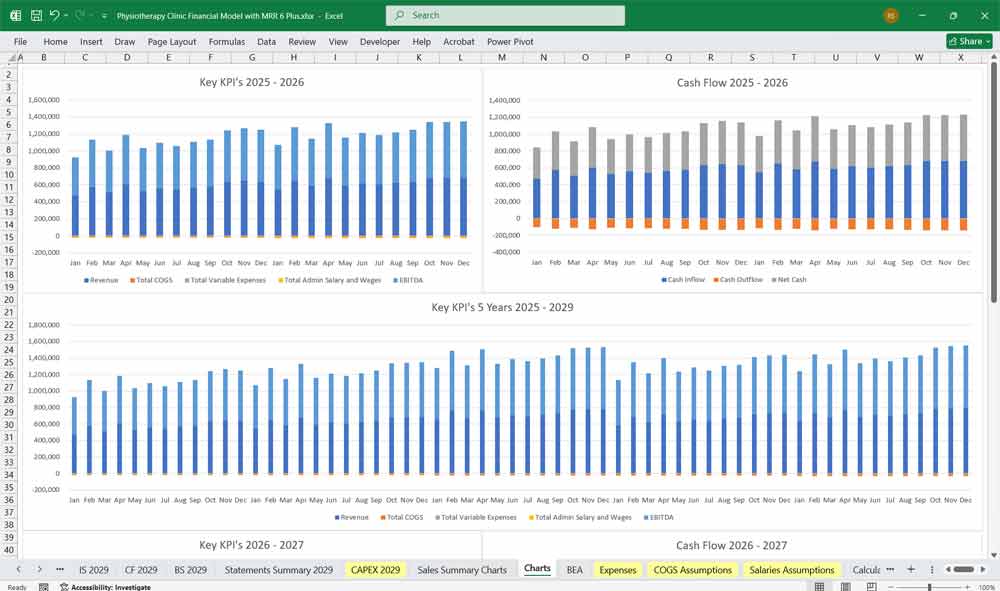
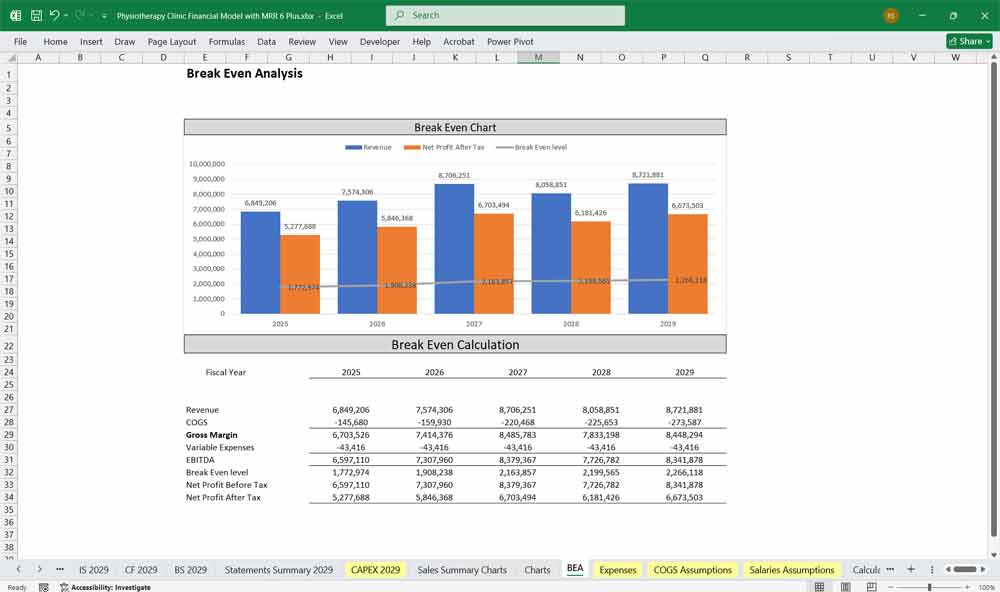
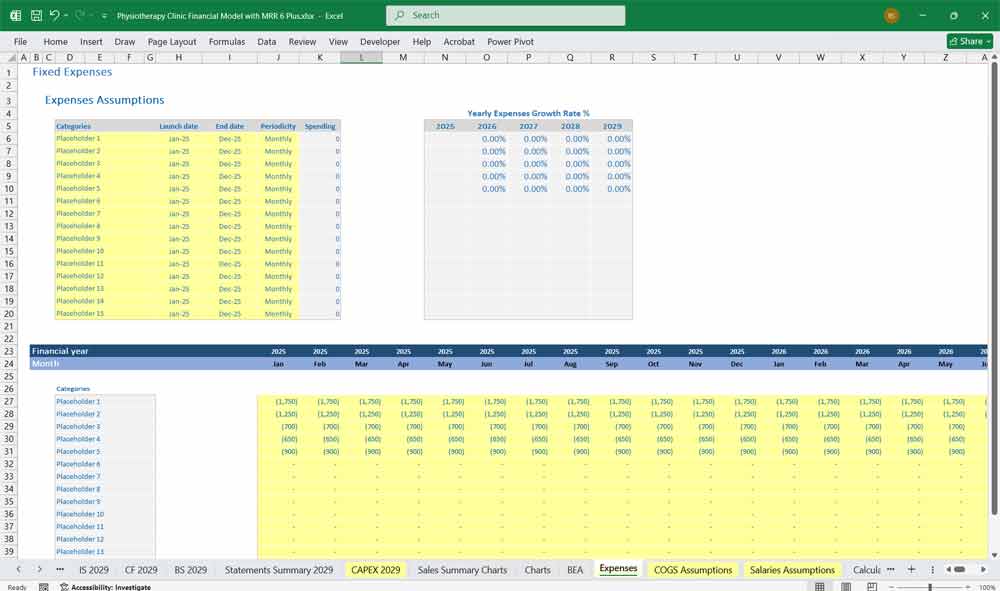
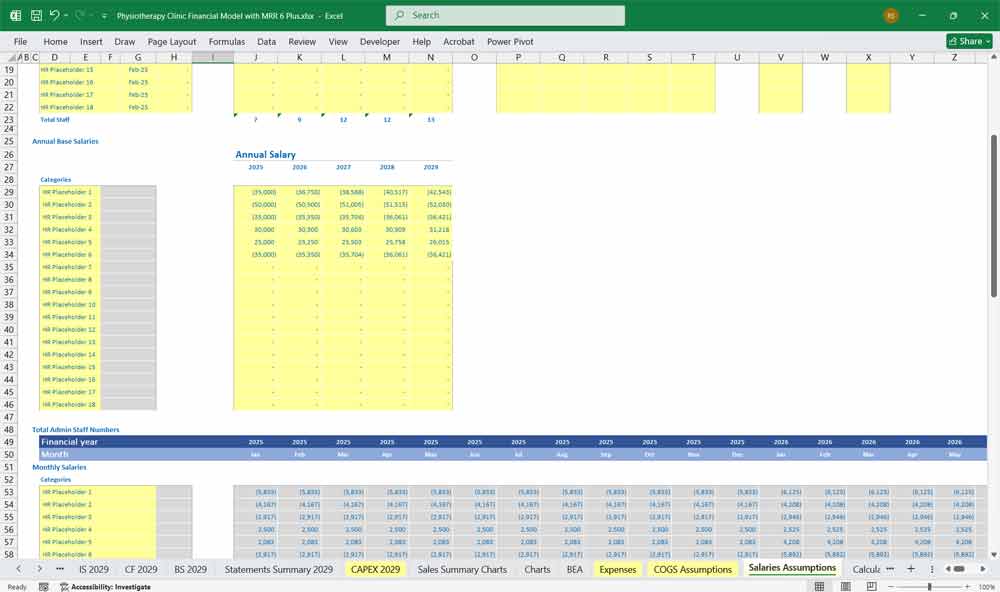
Conclusion & Key Metrics
Physiotherapy Clinic Financial Model financial KPIs that should be tracked:
- Gross Margin – (Revenue – COGS) / Revenue
- Net Profit Margin – Net Profit / Revenue
- Liquidity Ratio – Current Assets / Current Liabilities (should be >1)
- Break-even Point – When total revenue covers total costs.
- Average Revenue per Patient – Helps optimize pricing and marketing efforts.
Download Link On Next Page
